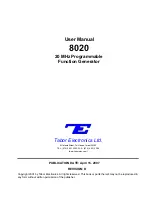
7
VIO 4K TPP PROGRAMMER'S GUIDE FOR v02.00.7X
2.4
Command principle and structure
2.4.1
VIO 4K™ control principle
VIO 4K™ functionalities are controlled through commands. Those commands allow reading or writing in
device registers.
VIO 4K™ TPP interface could be considered as a state machine, controlled by sending commands to read
or write its registers. Writing into registers modifies machine state. Current state of the machine is always
available by reading its registers.
Registers structure and size can range from a simple bit, up to multidimensional array of 32 bits words,
and also string. Note that reading or writing a value into a multidimensional register requires providing
indexes in addition to the register value.
Each register have a unique name, only made of letters, usually five, upper case or lower case. (three
exceptions having only one letter)
A command is made only of displayable ASCII characters (ranging from 0x21 up to 0x7E) and is ended
with a line feed character (LF) (ASCII 0x0A) that will be represented hereafter with the
L
F
symbol.
Commands are of 2 types: read commands or write commands, using the same syntax.
A write command is made of indexes values, followed by the register value, the register name and ended
by the
L
F
character.
A read command uses exactly the same syntax, except the register value that is omitted.
2.4.2
Write command structure
A write command is made of numeric values separated by a comma, followed by a group of up to 5 letters
defining the command and is ended with LF. (ASCII 0x0A)
Picture 1: Write command example
The last numerical field is the value to be written in the register.
The first numerical fields are “indexes values”, specifying on which dimension the command relates. The
number of indexes can range from 0 to 3 depending on the command.
§Command indexes and Command values
Each command shall be ended with the
L
F
character. (ASCII 0x0A)








































